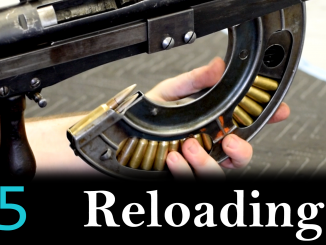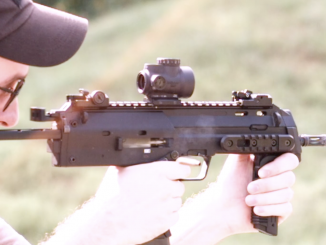Many people don’t realize that an extractor is not strictly necessary in many types of pistols – several early blowback models (notably the Bergmann 1896, as well as some later Spanish pistols) did not even have extractors. The residual chamber pressure after the bolt opens is often sufficient to push the case out of the chamber. In 20th century extractor-less pistols, one will usually find a tip-up barrel, to give the shooter a way to manually remove an unfired cartridge.
At any rate, the Schwarzlose 1898 in today’s video does have an extractor, it simply wasn’t working 100% in our shooting session. Two particular shots that seemed to function normally in real time turned out to actually be extractor failures when I reviewed the high-speed footage, and I thought they would make an excellent case study.




Thanks, Ian. I always look forward to your videos.
Some guns don’t have ejectors. My NAA Guardian .32 has an extractor but uses upward pressure from the next round in the magazine to eject a spent round. Yup, sometimes the last round gets stuck in the gun. But racking the slide with the next magazine inserted always clears it.
Keep those videos coming. As an unrepentant 7.65mm pistol slut yours are always the first I view on FB or Full30.
Proving yet again that even with a short-recoil, locked-breech action, there is nevertheless at least some residual gas pressure in the barrel/chamber section when the breech unlocks. And that that residual pressure is at least partly what expels the cartridge case from the chamber, whether it is “properly” extracted or not.
I’m not sure any short-recoil action has ever had enough dwell time to delay opening until the chamber pressure has dropped to zero relative to ambient air pressure (AAP).
Long-recoil actions like the Gabbett-Fairfax Mars, Browning (FN) Auto-5 shotgun, etc., may in fact have enough lag time to achieve AAP in the bore/chamber, before the unlock/extract/eject cycle begins on the barrel return-to-battery stroke.
Of course, no blowback is even close to AAP when the breech opens; if it was, the action probably wouldn’t work.
IMPO, extractor design isn’t as critical to proper short-recoil action reliability as ejector design. However the cartridge case leaves the chamber, by “hook” or under its own power, you definitely need something to make it jump ship before the breech starts coming back for’ard again.
Most smokestack jams and double-feeds seem to be ejector failures, not extractor failures. One notorious example being the legendary Dornaus & Dixon first-run Bren Ten 10mm Autos, that habitually inserted the ejected case back into the top of the magazine because there just wasn’t enough room in the CZ75-sized slide group for that big case to find the EXIT sign.
The later EAA version had a redesigned ejector, and whatever else you could say about it, at least it didn’t pull that trick.
Fun trivia note; Don Johnson (aka Sonny Crockett) carried a D&D Bren Ten in the first season of Miami Vice. It was replaced in the second season with the visually-similar S&W M645 .45 auto, because they couldn’t even get the Bren Ten to function reliably with blanks. In several episodes in “gunfight” sequences, if you hit slo-mo on your DVD player, you can clearly see Johnson trying to clear a jam in the 10mm.
Needless to say, in real life, Lt. Castillo would have told him to get a gun that actually works, and do it pronto.
cheers
eon
Y’also see that fly flittering around in slow-mo…
Great observation. As a first guess it would seem the spring might be a little tired after 100+ years. Looking at the preview photo from March, the ends of the spring appear slightly differently (maybe just camera angle) so the obvious try is to reverse the spring.
Looking closer, it looks like the guide rails are closed at the rear which would give an extra measure of safety as the guide lugs would have to fail as well as the guide loop to end up with a face full of bolt.
Schwarzlose 1898 extactor does not snap into its recess on the case in the pistol in the cocked mode. It was thought to catch the extractor groove when the striker rushed forward and arrived to its foremost position in the breecbolt under main spring tension, This piece is also works as the recoil spring and recoil springs are effective only via their mass through inertia at instant of firing. However, the extractor tip may correct its hold during rearward travel of barrel and breechbolt but if the striker rebounds or moves rearward by any cause. the case eventually misses the extractor catch.
You are on the path of discovery …. the main spring has too many roles and doesn’t handle them all that well.
Check out the YouTube “TFB TV” video from last week, where James Reeves shoots both a Glock and an MP5 without extractors; with and without suppressors; and with both brass and steel cased ammo. Results are interesting. (Not sure how to post the url from a tablet, but it’s not hard to find.)
I have seen it too and it proved – extractor is needed.
Now, why on this particular gun it is the opposite? Perhaps the fact that recoiling distance is long and the shell has acquired some momentum. Just a guess.
Hi, Denny,
The recoiling distance of Mannlicher 1898 is not the distance where the barrel is caught by “Barrel Holder”, it is some one fourth longer and, there should be no residual gas pressure inside the chamber at that lenght. What interesting in this particular pistol, should be, the presence of residual gas pressure as abling to powerfully blowing the empty case out of the chamber in a distance of such lenght. Normaly, an extractor is a must but instead, the residual gas makes its mission. It may be from the fact that, the mass of recoiling members, are still to little to exhaust of the remaining gas power within the time they remained as fastened with each other. The momentum share of empty case, by the fact that of its mass being too little, should not be as powerfull as to beat the resistance of friction of fouling and irregularities inside the chamber and, this should be the reason of why an extractor is needed in most times and in most action types in most cases.
Besides, the remaining gas inside a bottle necked case and chamber, may manage to remain the expelling power longer time as compared to a straight sided or slightly tapered case in a same type of mechanism. If that Model 1898 were in 9mm Parabellum caliber, it would be more probable for the empty case to be stopped in the chamber and the breechbolt to go on its rearward travel.
Sounds plausible; so it is influence of tapered case then. Quite educational, isn’t it?
Seems so.
Here is the article from TFB:
http://www.thefirearmblog.com/blog/2015/04/24/tfbtv-comment-myth-busting-can-shoot-pistol-without-extractor/
Hi Ian. I’ve been looking at your work for several years now. You asked for feedback and I thought about it, and this video made me want to say: keep doing what is most fascinating to you. If you go on a tangent I for one will read or view it. You do an excellent job, and thank you for putting the content up free. Sorry I’m not a member yet but it’s hard for me to see people complain about ads. Also, this post reminds me that the comments are usually interesting and insightful. I wondered how well an extractor on a firing pin could possibly have time to catch but strongarm points out it has at least as long as the travel during lockup (assuming the firing pin protrudes just so.) Keep up the good work guys. Lastly, my personal interest in your site is the history and evolution of design. You do a good job or putting designs in context of time, place, technology and other real-world constraints. As far as I’m concerned you could talk about tanks or trains or architecture or whatever makes you curious.